Kenya is losing its forests at an alarming rate.
According to a 2024 report by the Kenya Forest Service (KFS), the country sheds over 84,000 hectares of forest cover annually due to deforestation, with an additional 15,000 hectares lost to forest degradation.
That’s nearly 1.5 times the size of Nairobi City County vanishing each year, along with critical ecosystems, rainfall patterns, and the backbone of rural food security.
The economic toll of this loss is staggering, with environmental damage, declining agricultural productivity, and increasingly frequent natural disasters costing the country an estimated KSh 534 billion each year. Longer droughts, flash floods, dwindling biodiversity, reduced river flows, and declining crop yields have become hallmarks of this shifting climate.
The impact is felt most acutely in rural Kenya, where communities rely heavily on rain-fed agriculture and forests serve as vital water towers. Major rivers such as the Tana and Athi draw their strength from forested catchment areas. As these forests disappear, water sources dry up, threatening agriculture, livestock, hydropower, and urban water systems.
Yet amid this crisis, a quiet but promising transformation is underway, placing communities at the heart of forest restoration.
Increasingly, organizations across diverse sectors are adopting a community-first approach to environmental sustainability.
Among them is Minet, a leading risk advisory firm, which has pledged to plant 500,000 trees by 2030. So far, 46,000 seedlings have been sunk to the ground and more are coming.
But what sets Minet’s initiative apart is not the number of trees planted but how they are planted. Rather than taking a top-down approach, the company has entrusted local communities with ownership of the process. Community members are involved in preparing, planting, monitoring, and maintaining the trees, drawing on the insight that tree survival rates soar when local people are engaged from the start.
“When you empower people and respect their traditional knowledge, they take real ownership of initiatives that you introduce to them. We saw this recently in Kiambu county, where more than 100 local community members, led Minet in a tree planting initiative that had them play a central role in preparing the land, while pledging to nurture the seedlings to maturity. This is evidence that rural communities are increasing aware of the perils of climate, and just need some support to implement own solutions,” said Minet’s CEO, Sammy Muthui.
Community-led conservation is gaining traction across Kenya.
In regions like the Mau Forest Complex and Mount Kenya, community forest associations have curbed illegal logging and expanded forest cover using similar models.
These efforts are aligned with Kenya’s national goal to increase tree cover to 30% by 2032, up from the current 12.13%.
Minet’s work is part of this broader momentum, which is contributing carbon sequestration, ecosystem restoration and local economic development. Indeed, many of those involved in its projects especially women and youth, benefit from short-term incomes through nursery work, planting, and tree maintenance.
Meanwhile, other private-sector actors are taking note, as environmental, social, and governance (ESG) concerns become central to corporate agendas.
Many are beginning to realize that, ultimately, restoring Kenya’s forests will require enduring partnerships between government, civil society, the private sector, and, most critically, the communities who depend on the land.
In that sense, the young Minet trees now dotting Kenya’s hillsides and riverbanks represent what’s possible when communities lead and companies follow with trust and long-term commitment.






More Stories
IFC Channeling Africa’s Capital for Africa’s Sustainable Future
Now That There’s Lipa Pole Pole, There’s No Reason to Miss Out on Health Insurance
Naivas expands footprint in Redhill, reinforces commitment to affordability